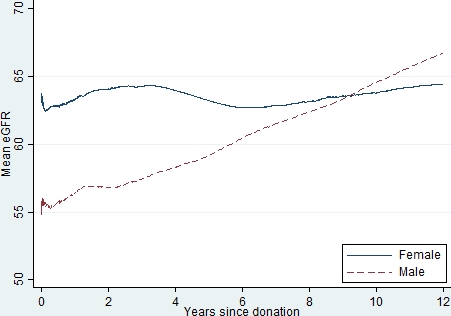Post-Donation eGFR and Hypertension in Living Kidney Donors.
1JHU, Baltimore
2University of Alabama, Birmingham, Birmingham.
Meeting: 2016 American Transplant Congress
Abstract number: C147
Keywords: Glomerular filtration rate (GFR), Kidney
Session Information
Session Name: Poster Session C: Kidney Donor Evaluation and Donor Nephrectomy
Session Type: Poster Session
Date: Monday, June 13, 2016
Session Time: 6:00pm-7:00pm
 Presentation Time: 6:00pm-7:00pm
Presentation Time: 6:00pm-7:00pm
Location: Halls C&D
Donor eGFR declines sharply after living kidney donation, but long-term eGFR trajectories and their relationship to post-donation hypertension are poorly understood.
METHODS: We retrospectively obtained 7805 post-donation serum creatinine values from medical records of 950 living donors from our center with median (IQR) followup 4.8 (1.6-9.0, max 29.4) y, and calculated eGFR using the CKD-EPI equation. We modeled eGFR trajectory using multilevel mixed-effects linear regression, accounting for individual variation in initial post-donation eGFR (random intercept) and eGFR trajectory (random slope).
RESULTS: Initial post-donation eGFR was lower in donors who were male, older, or African-American (AA), and higher in donors with higher pre-donation eGFR (Table). Greater BMI was associated with higher eGFR below BMI=28; above 28, the association was not statistically significant. eGFR increased by mean 2.6 per year in female donors and 5.7 per year in male donors (interaction p<0.001, Figure). However, eGFR declined over time for 23% of donors. Among donors without history of pre-donation hypertension, 19.8% of donors whose eGFR declined over time had incident post-donation hypertension (vs 9.9% of donors whose eGFR increased, [chi]2 p<0.01). The association between eGFR decline and post-donation hypertension persisted after adjusting for age, sex, race, and BMI (OR=1.3 2.2 3.9, p<0.01).
CONCLUSIONS: Following initial post-donation decline, eGFR increases over time in most living kidney donors, particularly male donors. However, donors with decline in post-donation eGFR over time should be monitored closely for hypertension and counseled about risk.
| Initial eGFR (non-AA female, age 40, BMI 25) | 64.8 65.7 66.6 |
| Initial difference for male donors | -5.3 -4.0 -2.7 |
| for AA donors | -5.1 -3.0 -0.7 |
| per 10y of age at donation | -2.7 -2.1 -1.4 |
| per 5 BMI units (at BMI<28) | -3.7 2.4 -1.1 |
| per 5 BMI units (at BMI>28) | -1.0 0.6 2.3 |
| per 10 units pre-donation eGFR | 4.4 4.8 5.3 |
| Change per 5 years post-donation (female) | 1.7 2.6 3.6 |
| per 5 years post-donation (male) | 4.5 5.7 7.0 |

CITATION INFORMATION: Massie A, Muzaale A, Anjum S, Leanza J, Alejo J, Locke J, Segev D. Post-Donation eGFR and Hypertension in Living Kidney Donors. Am J Transplant. 2016;16 (suppl 3).
To cite this abstract in AMA style:
Massie A, Muzaale A, Anjum S, Leanza J, Alejo J, Locke J, Segev D. Post-Donation eGFR and Hypertension in Living Kidney Donors. [abstract]. Am J Transplant. 2016; 16 (suppl 3). https://atcmeetingabstracts.com/abstract/post-donation-egfr-and-hypertension-in-living-kidney-donors/. Accessed December 17, 2025.« Back to 2016 American Transplant Congress
